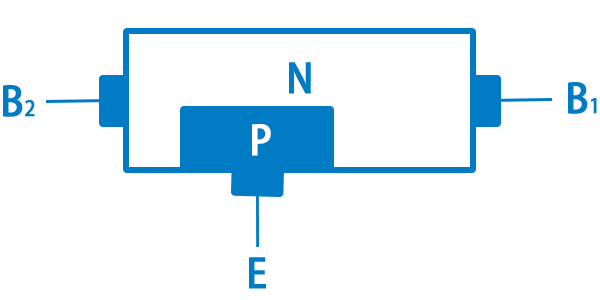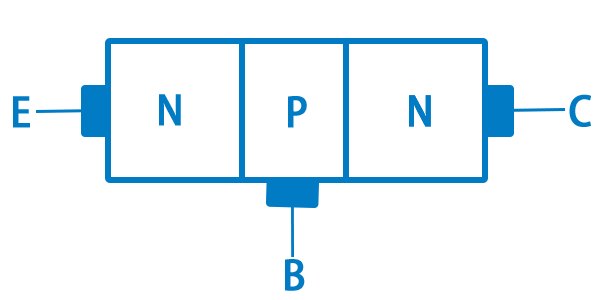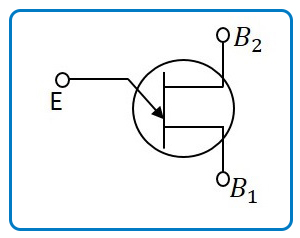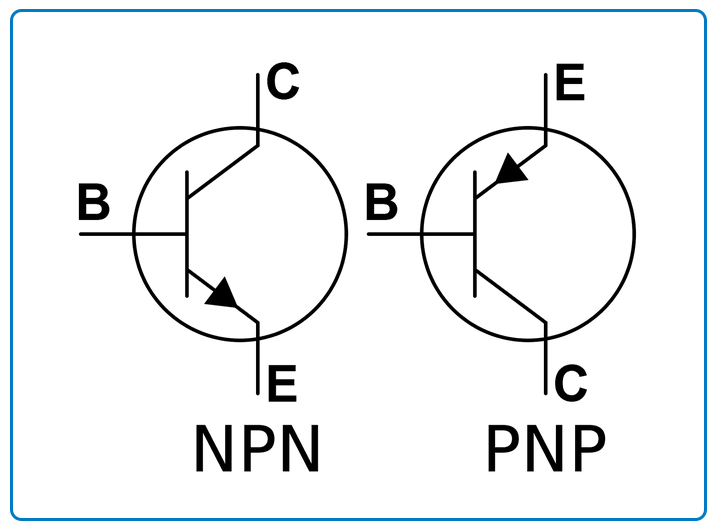Introduce
In the dynamic world of electronics, transistors play an indispensable role in shaping how devices function and interact. Among these pivotal components, Unijunction Transistors (UJT) and Bipolar Junction Transistors (BJT) are two key types often employed across various applications. Despite their shared classification as transistors, UJTs and BJTs exhibit distinct characteristics in terms of structure, operation mechanism, application areas, conduction type etc., which make them suitable for different electronic scenarios.
This article has aimed to highlight these key differences between UJTs and BJTs to assist you in choosing the right transistor type based on your specific requirements.
What is UJT?
A Unijunction Transistor (UJT) is a three-terminal semiconductor switching device. Unlike most other transistors which are based on junctions of n-type and p-type semiconductors, the UJT has only one pn-junction.

Unijunction Transistor (UJT) Structure Diagram
We can know from the structure diagram of unijunction transistor (UJT):
The UJT has two base terminals (Base 1 and Base 2), but unlike BJTs, these bases don't have identical characteristics.
A lightly-doped N-type silicon bar forms the main body of the transistor. This bar is attached to Base 2 terminal.
An alloyed P-region is fabricated at one side near the middle part of this N-bar which forms a single PN junction with it. This P-region is connected to Emitter terminal (E).
The region on either side of this emitter junction are known as Base1(B1) and Base2(B2).
The operation principle for UJTs involves changes in resistance between the emitter and base terminals when different voltages are applied. Under certain conditions, an initially high resistance can suddenly drop, leading to a sharp increase in current flow from emitter to base.
This unique characteristic makes them useful in various applications such as thyristor triggering circuits, pulse generators or timing circuits like oscillators and phase control.
What is BJT?
A Bipolar Junction Transistor (BJT) is a type of transistor that primarily uses both electron and hole charge carriers. The term "bipolar" refers to the use of both types of charge carriers in its operation. It's a three-terminal device, with the terminals referred to as the emitter, base, and collector.

Bipolar Junction Transistor (BJT) Structure Diagram
There are two types of BJTs:
NPN Transistor: In this type, a thin layer of p-type semiconductor is sandwiched between two n-type semiconductors.
PNP Transistor: Here, a thin layer of n-type semiconductor is sandwiched between two p-type semiconductors.
The main principle behind BJT operation involves controlling current flow from emitter to collector by modulating the amount of current at the base terminal.
The BJT has many applications due to its ability to amplify or switch signals:
Compare UJT and BJT
Next, we will compare the differences between UJT and BJT in an all-round way through the table.
| Feature | Unijunction Transistor (UJT) | Bipolar Junction Transistor (BJT) |
|---|
| Basic Structure | A lightly-doped N-type silicon bar forms the main body. An alloyed P-region is fabricated at one side near the middle part of this N-bar which forms a single PN junction with it. The region on either side of this emitter junction are known as Base1(B1) and Base2(B2). | Consists of three layers of semiconductor material, either NPN or PNP configuration. |
| Definition | A three-terminal semiconductor switching device that has only one PN junction and operates with majority charge carriers. | A three-layer, two PN-junction, semiconductor device that controls current flow. |
| Terminals | Emitter (E), Base 1 (B1), and Base 2 (B2). Bases don't have identical characteristics. | Emitter, base, and collector. In amplification operation mode, emitter-base junction is forward-biased while base-collector junction is reverse-biased. |
| Operation Principle | Changes in resistance between the emitter and base terminals when different voltages are applied can trigger a sharp increase in current flow from emitter to base. | Current flow from emitter to collector is controlled by modulating the amount of current at the base terminal. |
| Charge Carriers Involved | Majority carriers only; for an n-type UJT these would be electrons. | Both majority & minority carriers involved; for an npn BJT these would be electrons & holes respectively. |
| Applications | Useful in thyristor triggering circuits, pulse generators or timing circuits like oscillators and phase control. | Used as amplifiers or switches in various electronic devices such as televisions radios etc. |
| Full Form | Unijunction Transistor | Bipolar Junction Transistor |
| Circuit Symbol | 
Typically represented by an arrow pointing away from the base terminal. | 
For NPN(Left): Arrow on emitter pointing outwards; For PNP(Right): Arrow on emitter pointing inwards |
| Number of PN Junctions | Makes use of a single pn junction. | Incorporates two pn junctions in its structure. |
| Number of Semiconductor Layers | Makes use of three layers. | Incorporates three layers in its structure. |
Conclusion
To summarize, Unijunction Transistors (UJT) and Bipolar Junction Transistors (BJT), while both being transistors, differ significantly. UJTs are unipolar, voltage-controlled devices with one junction, primarily used as switches. Conversely, BJTs are bipolar current-controlled devices with two junctions and can function as both switches and amplifiers.
The choice between UJT or BJT will largely depend on your particular application needs - whether it is for high-speed digital circuits or robust pulse generation circuits. Understanding these differences helps in making informed decisions when selecting components for electronic projects.

Nantian Electronics a professional distributor of electronic components, providing a wide range of electronic products, saving you a lot of time, effort and cost through our meticulous order preparation and fast delivery service.
Share this post



FAQ
1. What is the main difference between UJT and BJT?
Unijunction Transistors (UJT) and Bipolar Junction Transistors (BJT) differ primarily in their structure, operation mechanism, and uses. UJTs have one junction and operate using majority charge carriers only, making them suitable for voltage-controlled switch applications like pulse generation circuits. In contrast, BJTs have two PN junctions and use both majority and minority charge carriers for operation. This allows them to function as both amplifiers and switches, making them versatile across a range of applications from audio amplification to high-speed switch controls.
2. What is the main purpose of UJT?
The Unijunction Transistor (UJT) is a three-terminal semiconductor device that has only one junction, unlike the Bipolar Junction Transistor (BJT). The main purpose of UJTs is in pulse generation and timing applications. They are widely used as triggering devices for thyristors due to their negative resistance characteristics. In addition, they can also function as simple oscillators or wave-shaping circuits to generate sawtooth waves when used in relaxation oscillator circuits. Despite being less versatile than BJTs, UJTs offer simplicity and reliability in certain specialized applications where precise timing or pulse generation is required.
3. What are the two types of BJT?
Bipolar Junction Transistors (BJTs) come in two types: NPN and PNP transistors.
An NPN transistor is composed of two layers of N-type semiconductor material with a layer of P-type sandwiched between them, while a PNP transistor has an arrangement that is the opposite - two layers of P-type material with an N-type layer in between. The direction of current flow differentiates these types.
It flows from collector to emitter in an NPN transistor and from emitter to collector in a PNP transistor. Although both can be used depending on circuit needs, the prevalence of NPN transistors tends to be higher due to their superior high-frequency characteristics and simpler manufacturing processes.
4. What is the advantage of UJT over BJT?
Unijunction Transistors (UJTs) offer several advantages over Bipolar Junction Transistors (BJTs). Their simpler structure, with only one PN junction compared to two in BJTs, makes them easier to understand and handle. UJTs exhibit a negative resistance region on their characteristic curve, enabling their use as oscillators or pulse generators—ideal for timing and triggering applications. They typically consume less power than BJTs due to their operational simplicity. UJTs also have high input impedance suitable for high-impedance circuits and are more stable across temperature variations, mitigating the risk of thermal runaway conditions that can affect BJTs.
5. What is the advantage of BJT over UJT?
Bipolar Junction Transistors (BJTs) offer several advantages over Unijunction Transistors (UJTs). They are more versatile, being used in a wide variety of applications such as amplification, oscillation, switching, and signal modulation. BJTs provide high current and voltage gain which makes them ideal for amplifying weak signals. While both BJTs and UJTs are affected by temperature changes, the impact on BJTS can be mitigated with appropriate biasing techniques. Additionally, unlike UJTs that only have one type available, both NPN and PNP types of BJT exist allowing for push-pull configurations. Lastly, a BJT has two junctions controlled by base current providing more control options compared to a UJT that only has one controllable junction.